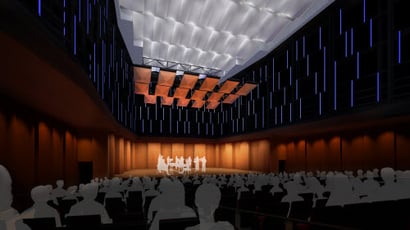Service Spotlight: Mechanical Engineering with Doug Seamark
![]()
As part of a continuing series on this blog, we’ll take a look at members from each of our services to highlight LPA’s integrated design process and showcase our commitment to sustainable design.
This month, we sat down with associate and mechanical engineer Doug Seamark to discuss the major role mechanical engineering plays throughout the life of a project and why working at an integrated design firm impacts the overall design solution in a positive way.
Q: How long have you worked at LPA?
A: I’ve been at LPA for about eight years. I came to LPA excited to work at an integrated design firm because I had some history in my past of working at both an architecture and engineering firm and a consulting firm. I felt the architect and engineer being together was a better model. Also, I’m from Southern California so a chance to get back here was a big thing for me.
Q: How does sustainable mechanical engineering impact the overall design solution?
Sustainable mechanical engineering touches a lot of different parts of the building. Not just the mechanical systems and the ductwork, but it impacts the building envelope and even things like lighting or the glazing selection and the glass. All of those things have to come together to do less. Our goal with mechanical systems is to have the building be as self-sufficient as possible. We have an opportunity to touch both the user experience and the building itself. Creating a comfortable building is critical for any sustainable space. If people don’t want to be in it, then what’s the point of having it? We also have a unique opportunity with ventilation to bring in fresh air and create spaces that are comfortable and crisp and healthy for both the wellness and the overall perception of the space itself. As mechanical engineers, we have the ability to have an impact on the interior of the building and then we also have the ability to impact the long-term performance of a building.
Q: Why do you think it’s valuable to work in an integrated design firm?
For me the value comes in relationships with people over time. As soon as we’re together and we’re working towards a common goal on a continual basis as a team, you begin to learn about the other disciplines so it makes you a better engineer. You start to understand what the structural engineer is working to achieve and what the architect is trying to accomplish and what the civil engineer is interested in doing. Building those relationships and understanding where they’re coming from has made me a better engineer and it’s allowed me to create better designs.
Q: What does a day in the life of Doug Seamark look like?
I start by day with my two-year-old and my five-year-old walking me out to my car and they give me a hug and send me on my way. From there, there’s very little that’s typical about my work day at LPA. I can go from a meeting with my team about schedule and staffing to a meeting with an architect about glazing selections to meeting with a civil engineer about campus utility piping to designing an air handler for a project. I like that I get to touch a lot of different things and be involved on a lot of different levels. One of the best things is probably time spent with the younger engineers discussing the projects, mentoring and teaching. That’s something that I truly enjoy.
 Q: What’s the most interesting project you’ve worked on? What did it entail?
Q: What’s the most interesting project you’ve worked on? What did it entail?
The new Coil School of Arts at Riverside Community College is one that has some unique challenges and we developed a more collaborative process to approach the specific challenges. It’s a higher education facility theater building and it’s acoustically challenging so there was a lot of strict acoustical requirements. We had a really great acoustic consultant and worked really closely with him to come up with a solution that both condition the space comfortably and quietly. Our challenge was finding a way to include large ducts that were really quiet with really low velocities into the theater. But we made it work and it turned out to be a well-designed, unique space.
Q: How does mechanical engineering impact the built environment?
Mechanical engineering, in my opinion, is one of the broadest disciplines that touches almost every aspect of a building and throughout the design process. As far as on a global level, there’s improvements for the environment as far as energy efficiency and net zero buildings and fewer emissions related to the buildings. And then there’s quality of space creating better places for people to be and to spend their time in. Those are all things that mechanical engineers are involved in being it acoustics, thermal comfort or ventilation. Those are all ways that a mechanical engineer would touch a building to improve the user experience and wellness.
